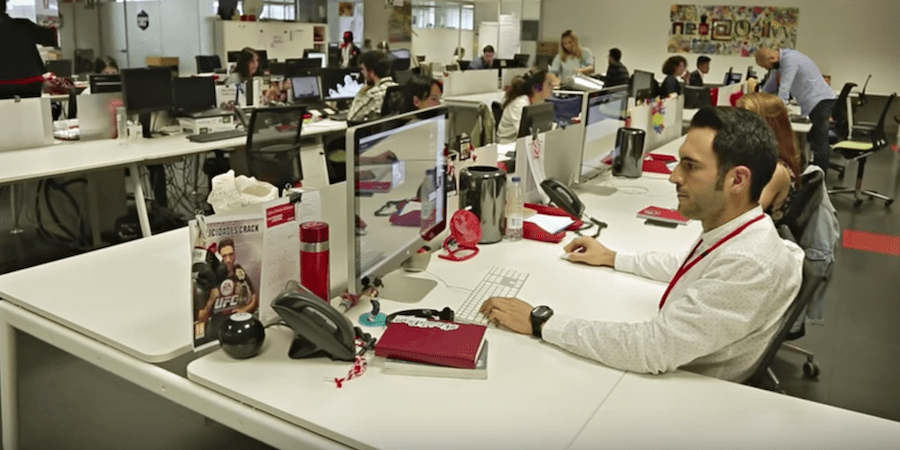
What a lean digital marketing agency look like
FEATURE – With lean thinking, Madrid-based Neo@Ogilvy is hoping to create a stronger connection with customers, thus learning to create value for them and redefining the overall purpose of marketing.
Words: Javier Oliete, General Manager, Neo@Ogilvy
I was a bit skeptical at first when people described lean to me as a “system for innovation”, using car manufacturers as examples of excellence in providing customer value. After all, I didn’t recall seeing many carmakers in the list of the world’s top brands. Facebook and Google, sure. But carmakers? And yet, there is certainly one automotive company that has been consistently innovating for the past 50 years, outranking its competitors and delivering value to millions of customers. I guess you know what company I am talking about.
A few months later, however, I realized that lean is not about cars or Toyota. It’s about putting people (both employees and clients) at the center of your strategy to develop better products and services.
In the past few years the advertising market has changed in such a way that keeping up has become a struggle for companies of all sides and sectors. As a startup, Neo@Ogilvy is of course experienced with agile and lean startup principles, but digital transformations are becoming more and more complex and lean thinking has come to represent a unique opportunity for us to transform ourselves.
There are a couple of ideas in particular that I have embraced wholeheartedly, and brought into the life of Neo@Ogilvy with enthusiasm.
The first is the importance of the gemba: our work is happening here and now, and overcoming the struggles our people face needs to become our focus as we strive to improve as a business. We need to find ways to make their work easier so that they can unleash their creativity.
The second concept is kaizen: small changes every day produce a huge change at the end of the week, and an amazing transformation at the end of the year. In a world where quick results and silver bullet solutions are expected, this was not a small realization.
When you first come into lean, something happens in your mind. Much like when you witness hunger and suffering, you want to do something about it. When we introduced the methodology in Neo@Ogilvy and saw how much we could improve, I couldn’t just sit there and watch.
What we learned is that the question that really matters is “Why?” – not “What?” If marketing is to stay relevant, I believe it needs to revisit what it is and does – and lean is a great tool to do that. What is the real purpose of advertising? What do our customers need? What does lean digital marketing looks like? In other words, why do we do what we do? Answering these questions calls for a complete transformation of Neo@Ogilvy: we want to learn to improve, involve our people in our transformation, and fully align with our customers and with end consumers (we are a B2B business, running advertising campaigns for other organizations, which include hotel chains, booking websites and supermarkets).
So in the past two years we have embarked on a lean journey, which todays thrives thanks to the involvement of the whole company.
LEAN AND MARKETING – A PERFECT MATCH
There is no reason marketing should not embrace lean thinking, as, in our experience, the two fit perfectly well together. In particular, we found that the powerful five principles of lean greatly resonate with the sort of activity we carry out.
Let me take you through our work, so that hopefully you too will see what I am talking about.
First, we need to start from the idea that not every customer is the same. While every customer is important, they all want something different – a different form of value, so to speak – and to successfully cater to them we need to take these differences into account. In every campaign we run, there is a time and place in which we can best reach out to each type of customer.
Let’s take a holiday booking website as an example. To understand what value we must provide our customer (the booking site) so that they can reach their clients (the tourists) in the best possible way and at the best possible time, we start by mapping their own client base. In other words, we specify customer value (the first principle of lean).
Understanding your client is important, but first you need to understand who your customer is! Our analysis of a customer database results in a segmentation of their clients into clusters: for example, we could identify a group of clients who spend more than a certain amount of money on their average holiday, and another one of returning, loyal clients. This allows us to target specific customers in the best possible way.
Next, we need to ask ourselves how these potential customers behave. What does their day look like? What devices do they use? What papers do they read? Are they active on social media? If so, on what platforms? Do they like the beach or city tours? Do they prefer eating out or all-inclusive resorts? Much like in a traditional lean company we map our value stream (the second principle), in a marketing agency like Neo@Ogilvy we map our customers’ customers’ process, observing their habits and behaviors in order to make an informed decision on what type of campaign to run.
For each of the target clusters we identify, we create personas – for example, a retired couple from Manchester who likes to book their packaged holidays in a resort well in advance and reads the Daily Telegraph. Understanding and mapping the context in which customers operate helps us immensely as we try to help our clients reach the right people, and to provide those people with the value they need. It also helps us to save resources: if we find out that 20% of the people reading a certain newspaper belong to our target segment, we can advertise to that 20% rather than to the entire readership.
Once we have understood who the customers are and how they behave, we need a plan to get to them – which means building our process to reach the right clients at the right time in the right place and with the right content.
For each segment, we need to understand the frequency and nature of the message we want to convey. We set up different paths for different segments (those who are contemplating the idea of a holiday; those who show a clear interest; those who are buying the holiday; and those who are returning customers).
We track our workflow for each of them using KPIs through technology, by doing things like monitoring how many people read promotional emails, how much time they spend watching a promotional video, and so on.
We then prepare targeted advertising, like a banner on a website you are visiting or a suggested video. To first-time customers we want to show something inspiring that might convince to buy our customer’s product; to returning ones, we might want to offer a discount on their next booking; and so on.
What this type of customized offering does is offer people the ability to pull (another lean principle), which is the most fundamental concept we have taken on at Neo@Ogilvy.
Marketing is a business of anticipation. If I can gather the right information and interpret it correctly, I can produce a campaign that reaps the most benefits for the organization I am helping. Say, for instance, we have a customer that is booking a holiday 110 days before departure – which is hugely valuable to a business. If this is something we can foresee, for example through marketing automation, we will be able to release a campaign five months in advance, thus reaching the customer before the tour operators.
To map and improve our work, we have started to use three types of boards (so far our visual efforts have focused on two clients):
- Daily Board, a breakdown of the activities in the workflow used to identify problems, the most serious of which are then fed to the Planning Board.
- Planning Board, used to highlight opportunities for improvement and potential countermeasures to the problems, using agile and scrum.
- Improvement Board, which assigns the resolution of each problem to a sponsor, who will be tasked with creating a team and fixing the issue, and maps progress in a Personal Kanban-like fashion.
The next step in our lean journey is to standardize jobs and responsibilities and to create a clearer hierarchy.
THE OPPORTUNITY OF TECHNOLOGY
Technology allows us to do things that we wouldn’t have thought possible even just a few years ago. It gives us visibility over our customer base, showing us where the most lucrative opportunities lie and offering us a direct path to value-creation: by knowing who our customers are and what they are interested in, we can help our client organizations to offer them exactly what they need, when they need it. Knowledge of the customer and analytics allow us to get very granular in our offering.
With a client of ours, hotel chain Iberostar, we have seen incredible results thanks to our work with lean and our use of technology: the click-through rate (the number of people clicking on a link in an email – a commonly used KPI to measure the effectiveness of a campaign) has increased by 46%; the conversion rate (the number of visitors who take a certain action as a result of our communication – like booking a holiday) by 187%; the cost-per-action (CPA) has gone down by 48% while our cost-per-mille (cost per thousand impressions) has gone up 118% – which means we are providing a higher-quality campaign because it reaches the people it is supposed to. Overall, the ROI of the campaign has improved by 70% compared to a traditional approach.
Yes, technology brings opportunities galore, and we haven’t quite seen them all yet. There has been a lot of talk lately about the Internet of Things, for instance. This technological development – which provides every-day objects, like appliances, with network connectivity – represents a huge opportunity for us all. It will empower consumers and bring them closer and closer to manufacturers and service providers. It will also change what we do as companies, forcing us to provide customized service to each customer.
I have no doubt that lean companies will find it easier to take advantage of the opportunities represented by the Internet of Things – after all, they already know what it means to understand what customer value looks like. Personally, I see lean as the thread connecting marketing with the end user. Our work to map the customer base in order to understand the value we must provide would be much more difficult without the teachings of lean on our side.
THE AUTHOR

Read more


WOMACK'S YOKOTEN – Last month nations signed a greenhouse gas emissions deal – on paper, an insurance policy against climate change. But if action is to follow promises, the cost of the insurance premium, as perceived by voters and governments, must be lowered. Lean thinking can help.


WEB SERIES - In this episode, we head to Chilean Patagonia to visit a manufacturer of fish feed that turned to Lean Thinking to improve yield and eliminate inventory gaps and stock-outs.


THE LEAN BAKERY – In this episode of our video series, we visit 365's super-lean workshop, where small batches and a clever use of space allow for unprecedented levels of flexibility in manufacture.


FEATURE – Have you ever wondered how lean tools and principles might apply to writing? To inspire you to document your learnings, our editor offers a guide for aspiring writers in our community.

